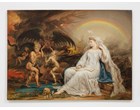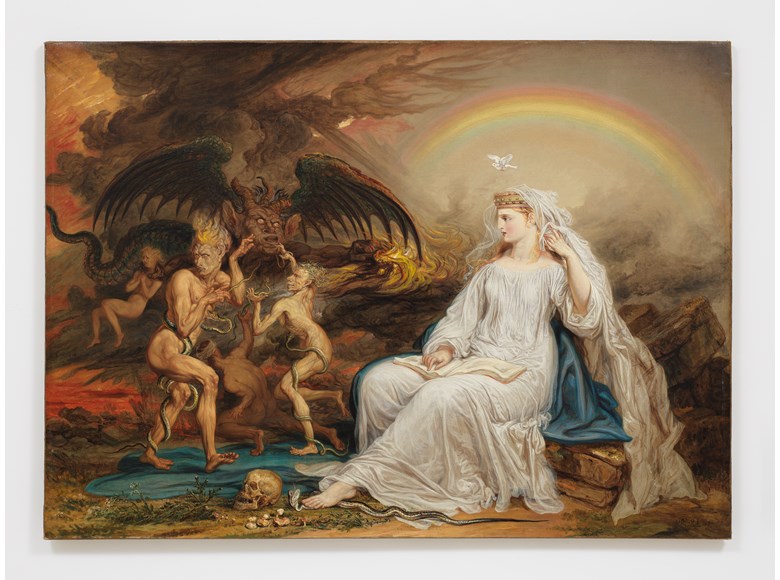 BACK TO GALLERY
BACK TO GALLERY
French & Company
James Ward
Ignorance, Envy and Jealousy
A highly unusual image that includes images of Calumny and Truth dressed in white
48 x 66 inches
description
A face-off between neoclassical and manga imagery, James Ward’s Ignorance, Envy and Jealousy was exhibited at the Royal Academy in 1838. Its full title was Ignorance, Envy and Jealousy filling the throat and widening the mouth of Calumny; endeavoring to bear down Truth as an unshaken Pyramid founded on a rock. After the painting entered the collection of the Royal Shakespeare Company, the subject became known as Miranda and Caliban from The Tempest.
The painting depicts the conflict between good and evil. Seated below a rainbow and dove, Truth directs Calumny to the bible in her lap. Snakes encircle Envy and Jealousy, with the blindfolded Ignorance between them. Dressed in white, Truth’s profile and clinging drapery resemble figures from the Elgin Marbles, which went on public view in 1832. According to Edward Nygren, Ward took these emblems from Ripa's Iconologia and Alciati's Emblemata. For the composition, Ward may have looked at William Blake’s Good and Evil Angels print of 1795-1805.
Ward was elected an Associate of the Royal Academy in 1807 and a full member by 1811. From its founding in 1768, the R.A. recognized history and allegorical paintings as the highest form of artistic expression. Critics were not appreciative of Ward’s efforts, with one reviewer writing in 1835 ‘His riches are in horses and cattle and he should not quit the farm’.
After training as an engraver, Ward translated works by Beechey, Hoppner and Lawrence into mezzotints. A prolific draftsman, Ward noticed and recorded small details such as the mushrooms and thistles at the bottom of the canvas. Memorable paintings by him include Bulls Fighting (V & A); The Gordale Scar (Tate); and a Man Struggling with a Boa Constrictor (Yale Center for British Art). In a Charles X frame, Ignorance, Envy and Jealousy is Ward’s most surprising painting, impressive in size and prescient in imagery.
The painting depicts the conflict between good and evil. Seated below a rainbow and dove, Truth directs Calumny to the bible in her lap. Snakes encircle Envy and Jealousy, with the blindfolded Ignorance between them. Dressed in white, Truth’s profile and clinging drapery resemble figures from the Elgin Marbles, which went on public view in 1832. According to Edward Nygren, Ward took these emblems from Ripa's Iconologia and Alciati's Emblemata. For the composition, Ward may have looked at William Blake’s Good and Evil Angels print of 1795-1805.
Ward was elected an Associate of the Royal Academy in 1807 and a full member by 1811. From its founding in 1768, the R.A. recognized history and allegorical paintings as the highest form of artistic expression. Critics were not appreciative of Ward’s efforts, with one reviewer writing in 1835 ‘His riches are in horses and cattle and he should not quit the farm’.
After training as an engraver, Ward translated works by Beechey, Hoppner and Lawrence into mezzotints. A prolific draftsman, Ward noticed and recorded small details such as the mushrooms and thistles at the bottom of the canvas. Memorable paintings by him include Bulls Fighting (V & A); The Gordale Scar (Tate); and a Man Struggling with a Boa Constrictor (Yale Center for British Art). In a Charles X frame, Ignorance, Envy and Jealousy is Ward’s most surprising painting, impressive in size and prescient in imagery.






 SEND AN EMAIL
SEND AN EMAIL
 (212) 535-3330
(212) 535-3330